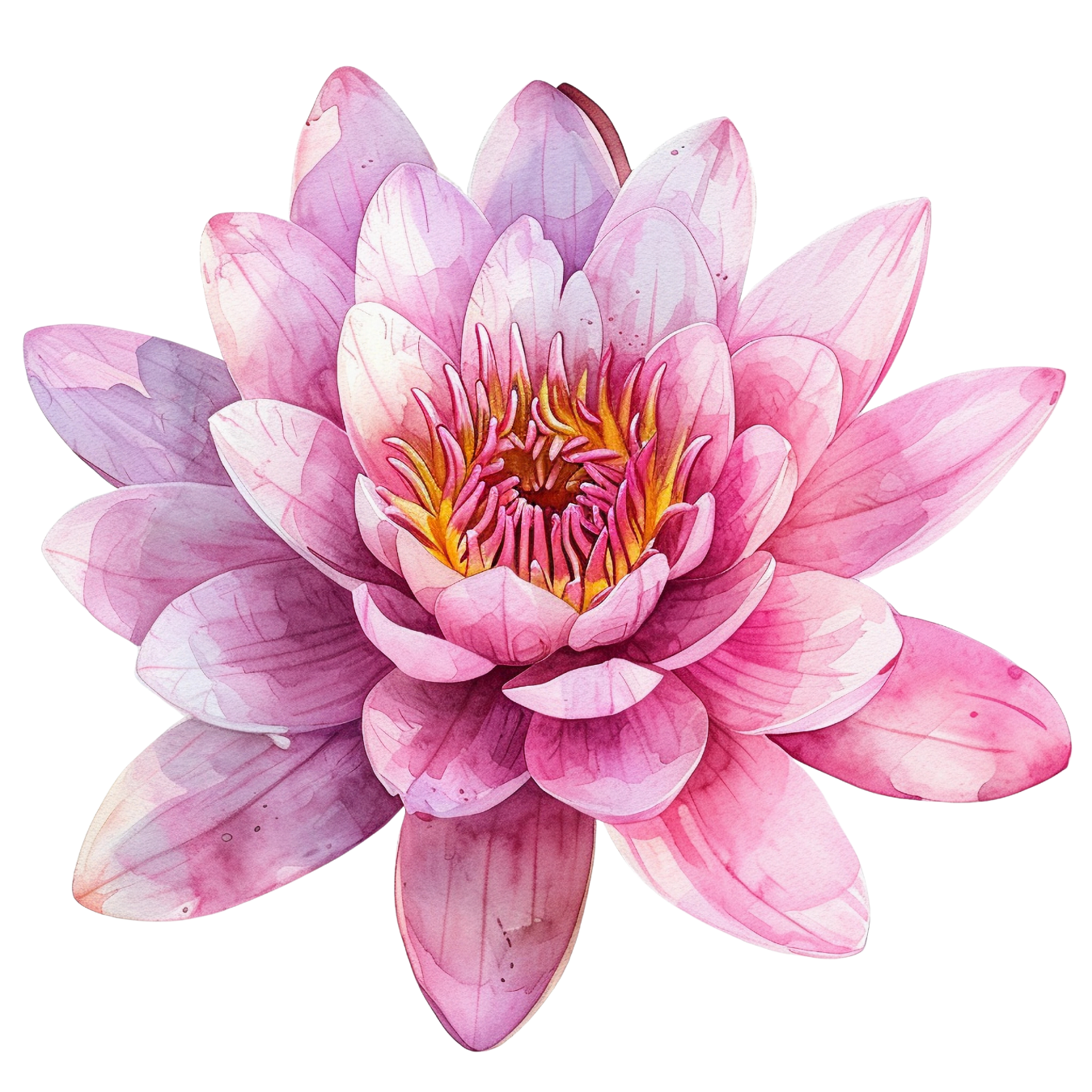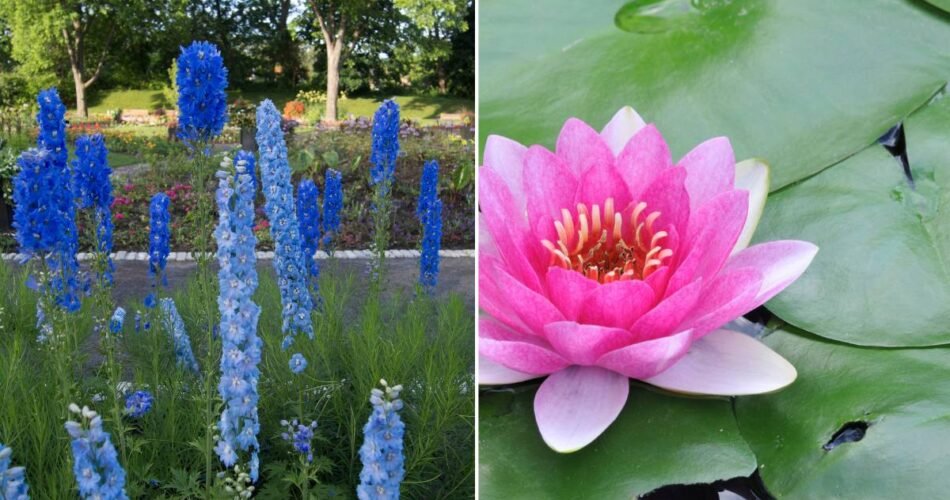What are the July birth flowers?
July, the month of high summer, is represented by two enchanting flowers: Larkspurs and Water Lilies. Larkspurs, with their tall spikes of colorful blossoms, symbolize an open heart and ardent attachment, reflecting the warmth and intensity of July. Water Lilies, serene and majestic, floating on calm waters, signify purity, enlightenment, and rebirth, mirroring the tranquil and reflective aspect of this summer month.
In this post, we will delve into the world of birth month flowers, explore their meanings, origins, and fascinating facts. We will also discover how these flowers inspire art, creativity, and thoughtful gift ideas. So, let’s embark on this journey and uncover the beauty and meaning of July birth month flowers.
Related Post: Birth Flowers for all 12 months
History & Origin of Larkspurs

Larkspurs, known scientifically as Delphinium, boast a rich history and mythology. The name “Delphinium” is derived from the Greek word “delphis,” meaning dolphin, due to the shape of the flower’s nectary resembling a dolphin’s back. Larkspurs have been cultivated and cherished for centuries, adored for their striking spikes of flowers that come in shades of blue, purple, pink, and white.
The association of Larkspurs with July stems from their peak blooming period in many regions during this month. In folklore, Larkspurs are believed to protect against ghosts and negative energies, and their varied colors each carry different meanings, from lightness and levity to deep affection and strong bonds, echoing the diverse moods of July.
What does Larkspurs mean?
Larkspurs are rich in symbolism, with each color conveying a unique message:
- Pink Larkspurs signify fickleness, expressing a whimsical or ever-changing nature.
- White Larkspurs represent happiness, suggesting a pure and joyful disposition.
- Purple Larkspurs symbolize first love or a strong attachment, denoting deep emotional connections.
- Blue Larkspurs stand for dignity and grace, reflecting a serene and noble spirit.




Overall, Larkspurs symbolize an open heart and ardent attachment, mirroring the depth of emotions and the bonds formed during the warmth of July.
How to care for Larkspurs
Larkspurs, with their towering spikes of vibrant flowers, can be a stunning addition to any garden if cared for properly:
- Sunlight: Larkspurs thrive in full sun but can tolerate partial shade. Ensure they receive at least 6 hours of sunlight daily for optimal growth.
- Soil: These flowers prefer well-draining, rich soil. Incorporating organic matter into the soil can improve its quality and support healthy plant growth.
- Watering: Keep the soil consistently moist, especially during dry periods. Larkspurs require regular watering but be cautious of overwatering to avoid root rot.
- Support: Due to their height, Larkspur plants may need staking to prevent them from falling over, especially in windy areas or when the flower spikes are in full bloom.
- Fertilization: Apply a balanced, slow-release fertilizer in the spring to encourage vigorous growth and abundant flowering.
Interesting or less known facts about Larkspurs
- Ancient Use: Larkspurs were used by Native Americans and early settlers for their blue dye and for medicinal purposes, particularly to treat ailments ranging from scorpion stings to eye irritations.
- Toxic Beauty: Despite their beauty, all parts of the Larkspur plant are toxic if ingested, containing alkaloids that can be harmful to humans and animals.
- Butterfly Attractors: Larkspurs are known for attracting butterflies to the garden, adding another layer of beauty and natural charm to their surroundings.
- Shakespearean Reference: Larkspurs, particularly the blue variety, are believed to have been referenced in Shakespeare’s works, symbolizing lightness and levity.
History & Origin of Water Lilies

Water Lilies (Nymphaea), with their majestic blooms floating on water, have fascinated cultures around the world for millennia. These aquatic plants are native to temperate and tropical climates globally and are especially revered in ancient Egyptian culture, where they were a symbol of the sun and rebirth due to their cycle of closing at night and re-opening in the morning.
The association of Water Lilies with July is likely due to their full bloom during this month in many parts of the world, when ponds and lakes are at their most serene and inviting. In various cultures, Water Lilies symbolize purity, enlightenment, and the seamless transition between the non-physical and physical realms, mirroring the reflective and tranquil aspect of July’s warm days and nights.
What does Water Lilies mean?
Water Lilies are not just visually stunning; they are imbued with deep symbolism:
- Purity and Enlightenment: The way Water Lilies rise from muddy waters to bloom beautifully above the surface makes them symbols of purity, spiritual enlightenment, and rebirth.
- Peace and Tranquility: Their serene presence on still waters conveys a sense of peace and tranquility, reflecting the calm and introspective aspect of life.
- Femininity and Beauty: In various cultures, Water Lilies are associated with femininity and beauty, celebrating the grace and nurturing aspect of womanhood.
How to care for Water Lilies
Caring for Water Lilies involves understanding their aquatic environment:
- Planting Depth: Water Lilies thrive when planted at the correct depth, typically between 12 to 18 inches below the water’s surface, depending on the variety.
- Sunlight: These plants prefer full sun to bloom profusely. Aim for at least 6 hours of direct sunlight each day.
- Water Quality: Maintain clean water to prevent algae growth, which can compete with Water Lilies for nutrients and sunlight.
- Fertilization: Use special aquatic plant fertilizer tablets to feed Water Lilies during the growing season, ensuring they have the nutrients needed for healthy growth and blooming.
- Winter Care: In colder climates, Water Lilies may need to be moved to deeper parts of a pond to prevent the rhizomes from freezing, or they can be overwintered indoors in regions where ponds freeze over.
Interesting or less known facts about Water Lilies
- Ancient Symbolism: In ancient Egypt, Water Lilies were revered and often depicted in art and hieroglyphics, symbolizing the sun and rebirth due to their daily cycle of bloom and retreat.
- Night Bloomers: While many Water Lilies open their blossoms in the morning, there are varieties, such as the tropical night-blooming Water Lilies, that open their flowers at dusk and close them at dawn, reversing the typical daily cycle.
- Medicinal Properties: Parts of the Water Lily plant have been used in traditional medicine across various cultures to treat ailments ranging from coughs and colds to skin conditions and inflammation.
- Diverse Ecosystem: Water Lilies play a crucial role in their aquatic ecosystems, providing habitat and protection for fish and other wildlife while helping to stabilize water temperatures and oxygen levels.
July Birth Flower Comparison
| Month | Birth Flower | Characteristics | Symbolism |
|---|---|---|---|
| July | Larkspur | Tall spikes of flowers, various colors including pink, white, and purple | Lightness, levity, open heart |
Water Lily | Aquatic, large disc-like flowers, often white or pink | Purity of heart, enlightenment, rebirth |
What are the popular July birth flower gifts?
Larkspurs and Water Lilies, July’s birth flowers, offer a plethora of gifting options that capture the essence of summer:
- Floral Arrangements: Bouquets featuring the vibrant spikes of Larkspurs or the serene blooms of Water Lilies make for stunning gifts, embodying the warmth and vibrancy of July.
- Garden Additions: Gifting potted Larkspurs or Water Lily tubers for pond planting can add beauty and charm to any outdoor space, allowing the recipient to enjoy their splendor all season long.
- Themed Decor: Items adorned with Larkspur or Water Lily motifs, such as throw pillows, wall art, or tableware, can bring the beauty of these flowers indoors, enhancing any home decor.
- Botanical Jewelry: Elegant pieces of jewelry inspired by the delicate form of Larkspurs or the serene beauty of Water Lilies can make for a thoughtful and personal gift, allowing the wearer to carry a piece of July with them wherever they go.
Here are some more gift ideas featuring July’s birth flowers to explore.













What are some artistic or creative applications of July birth flower gifts?
Larkspurs and Water Lilies inspire a variety of creative and artistic applications:
- Botanical Illustrations: These flowers can be beautifully rendered in detailed botanical illustrations, capturing their intricate forms and vibrant colors.
- Home Decor: Incorporate Larkspur and Water Lily motifs into home decor items such as tapestries, vases, or lampshades for a touch of summer elegance.
- Fashion Accessories: Create or purchase accessories like scarves, hats, or bags featuring Larkspur or Water Lily designs to add a floral flair to any outfit.
- Tattoo Art: Tattoos of Larkspurs or Water Lilies can symbolize the wearer’s birth month or represent the qualities these flowers embody, such as purity, an open heart, or the joy of life.
Conclusion
The Larkspur and Water Lily, as July’s birth flowers, bring the full vibrancy and tranquility of summer to life. Their unique beauty and symbolism offer endless possibilities for celebration and creativity. Whether through gardening, floral arrangements, or artistic expression, these flowers remind us to embrace the warmth of the season and the beauty of nature’s cycles. Let’s cherish and share the splendor of Larkspurs and Water Lilies, making every moment in July a little more beautiful.
10 FAQs
What are the birth flowers for July?
Larkspurs and Water Lilies.
What do Larkspurs symbolize?
Open heart and ardent attachment.
What is the meaning behind Water Lilies?
Purity, enlightenment, and rebirth.
Can Larkspurs be grown indoors?
They are best suited to outdoor gardens but can be enjoyed indoors as cut flowers.
Are Water Lilies difficult to care for?
They require specific aquatic conditions but are relatively low-maintenance with the right setup.
Do Larkspurs come in different colors?
Yes, they can be found in shades of blue, purple, pink, and white.
How long do Water Lily flowers last?
Each bloom typically lasts for a few days, but plants can produce flowers continuously in summer.
Are Larkspurs toxic?
Yes, all parts of the Larkspur plant are toxic if ingested.
Can Water Lilies survive in cold climates?
Hardy varieties can survive winters in ponds, but tropical types may need to be overwintered indoors.
How can I use Larkspurs in a bouquet without them wilting?
Keep them well-hydrated and use floral preservatives to extend their freshness.

